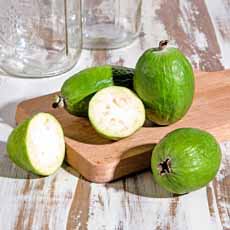TIP OF THE DAY: Try A Feijoa
 Feijoa, a native of South America now grown in other subtropical climates (photo courtesy Baldor Specialty Foods). |
The feijoa (FEE-joe-ah)is an egg-shaped fruit with a thin, lime-green skin. The fruit originated in the highlands of southern Brazil, parts of Colombia, Uruguay, Paraguay and northern Argentina. Today it is grown around the world in semi-tropical climates. New Zealand is a large grower. While not well known in the U.S., its flavor calls up better-known fruits. Feijoa is sometimes called the pineapple guava (guava is a brother*). Other nicknames include Brazilian guava, fig guava and guavasteen. |
|
|
Although the skin is edible, the fruit usually is eaten by cutting it in half, then scooping out the pulp with a spoon, like a kiwi. No spoon? Cut off an end with a knife, or take a bite to expose the flesh and squeeze the pulp into your mouth. In recipes beyond fruit salad and stewed fruit, feijoa is as versatile as most fruits. In New Zealand, they are: Fruits are at optimum maturity when the seed pulp has turned into a clear jelly, with no hint of browning. Once the seed pulp and surrounding flesh begin to brown, the fruit is overripe. Overripe fruit can of course be eaten, juiced, or turned into jam or compote [source]. Have fun with it! *Both feijoa and guava are members have the same phylogeny, all the way down to the Family level. The phylogeny is Kingdom Plantae, Clade Angiosperms, Clade Eudicots, Clade Rosids, Order Myrtales, Family Myrtaceae. They then split into different genuses. The genus and species for feijoa is Acca sellowiana. For guava, it is Psidium guajava. |
||


